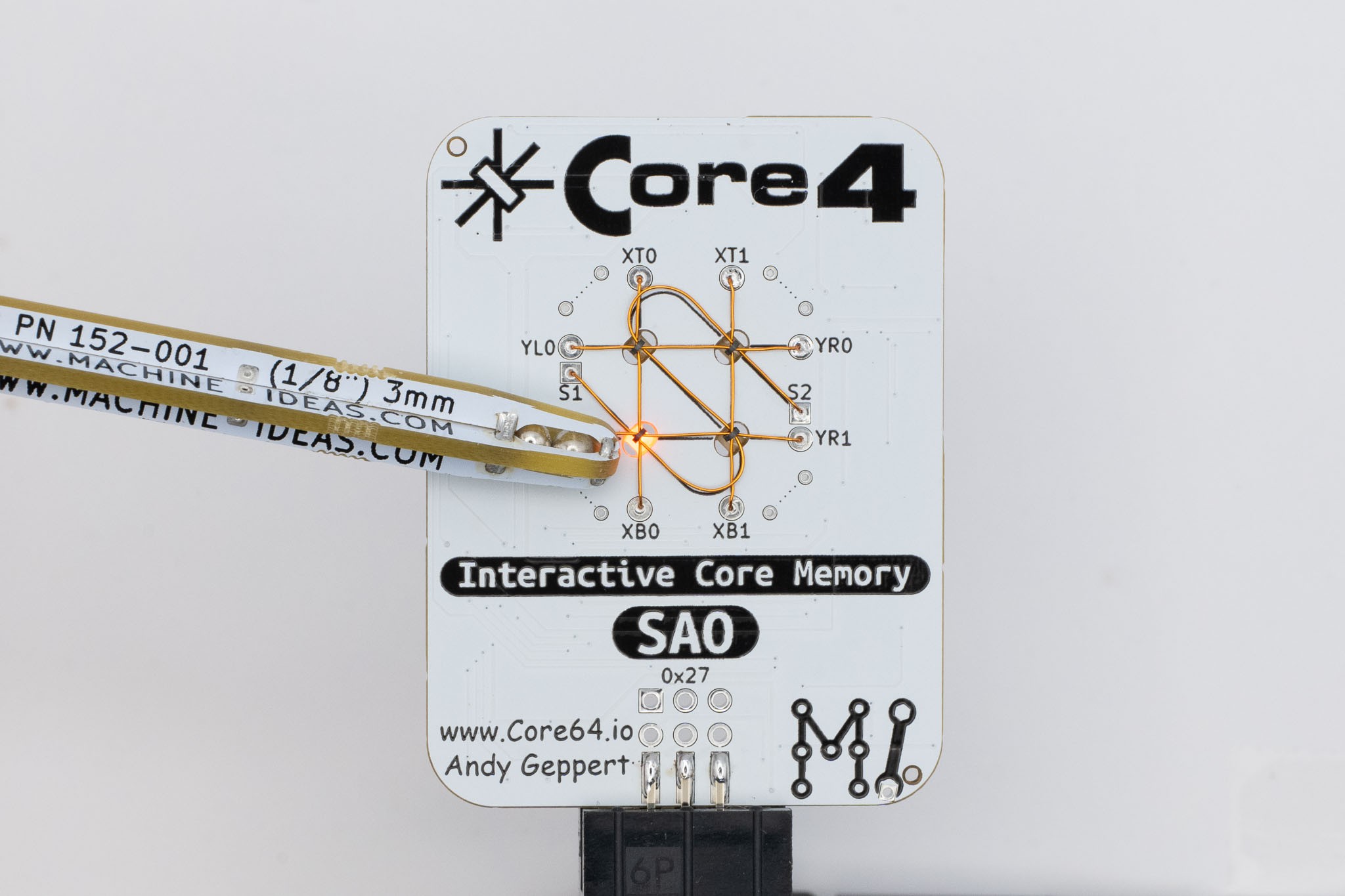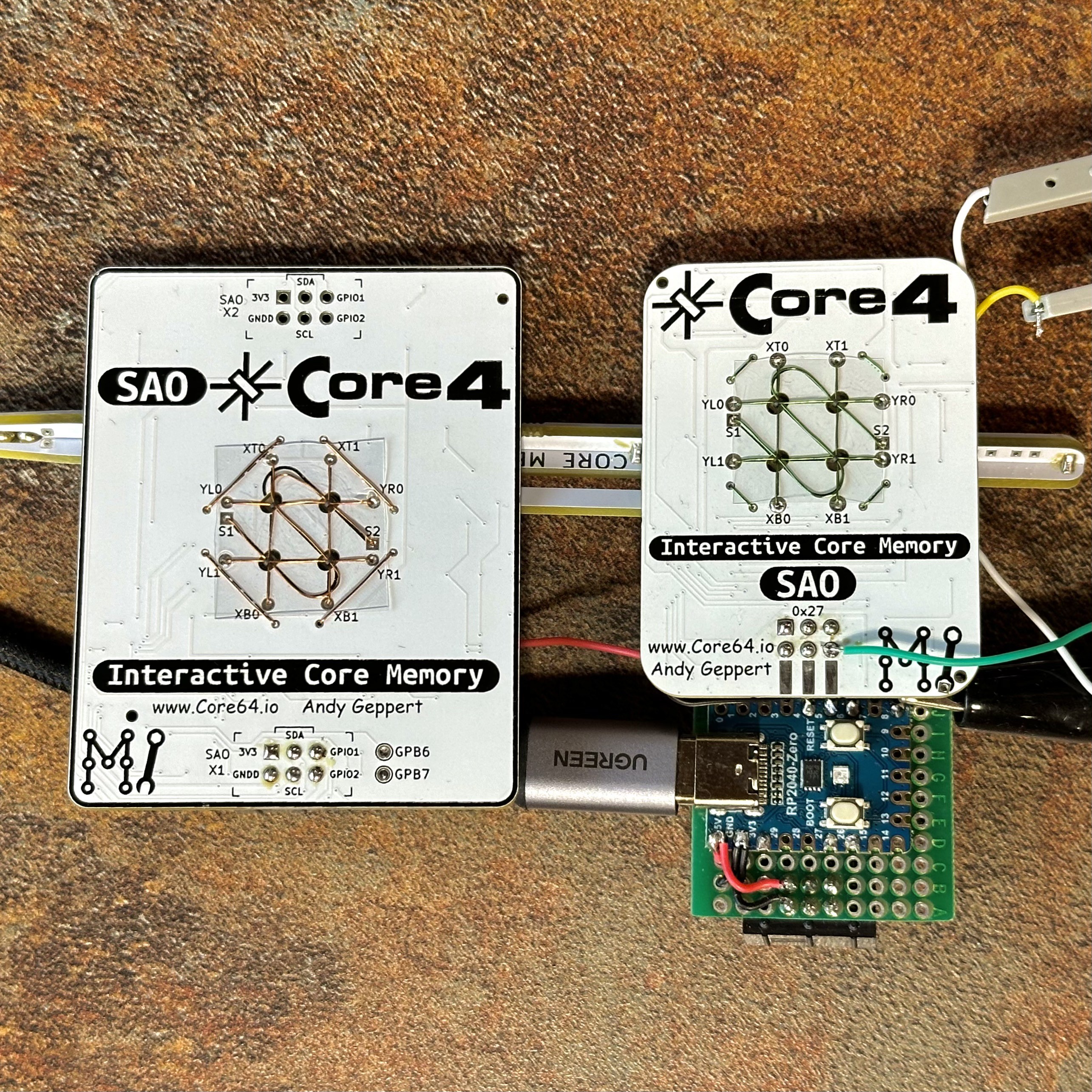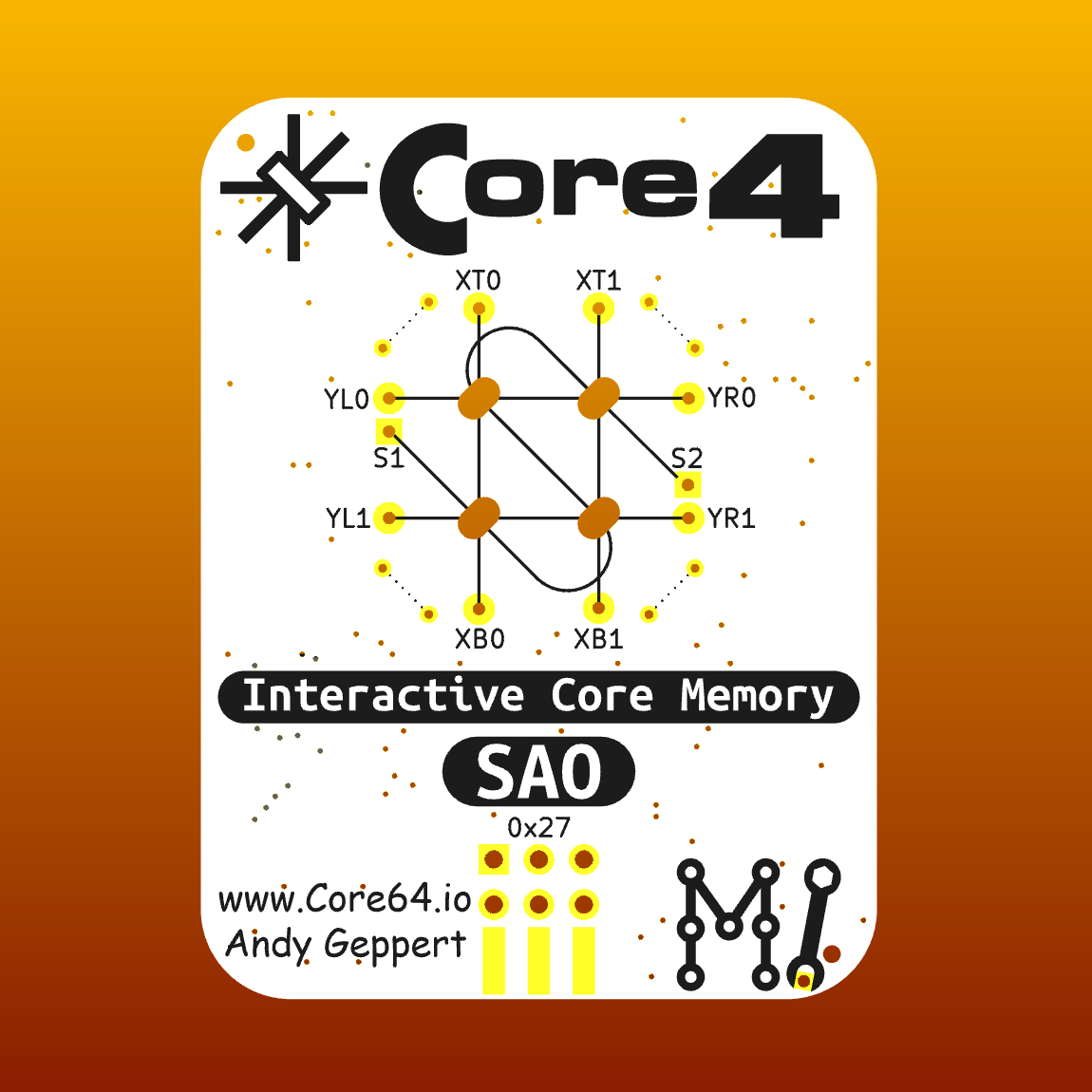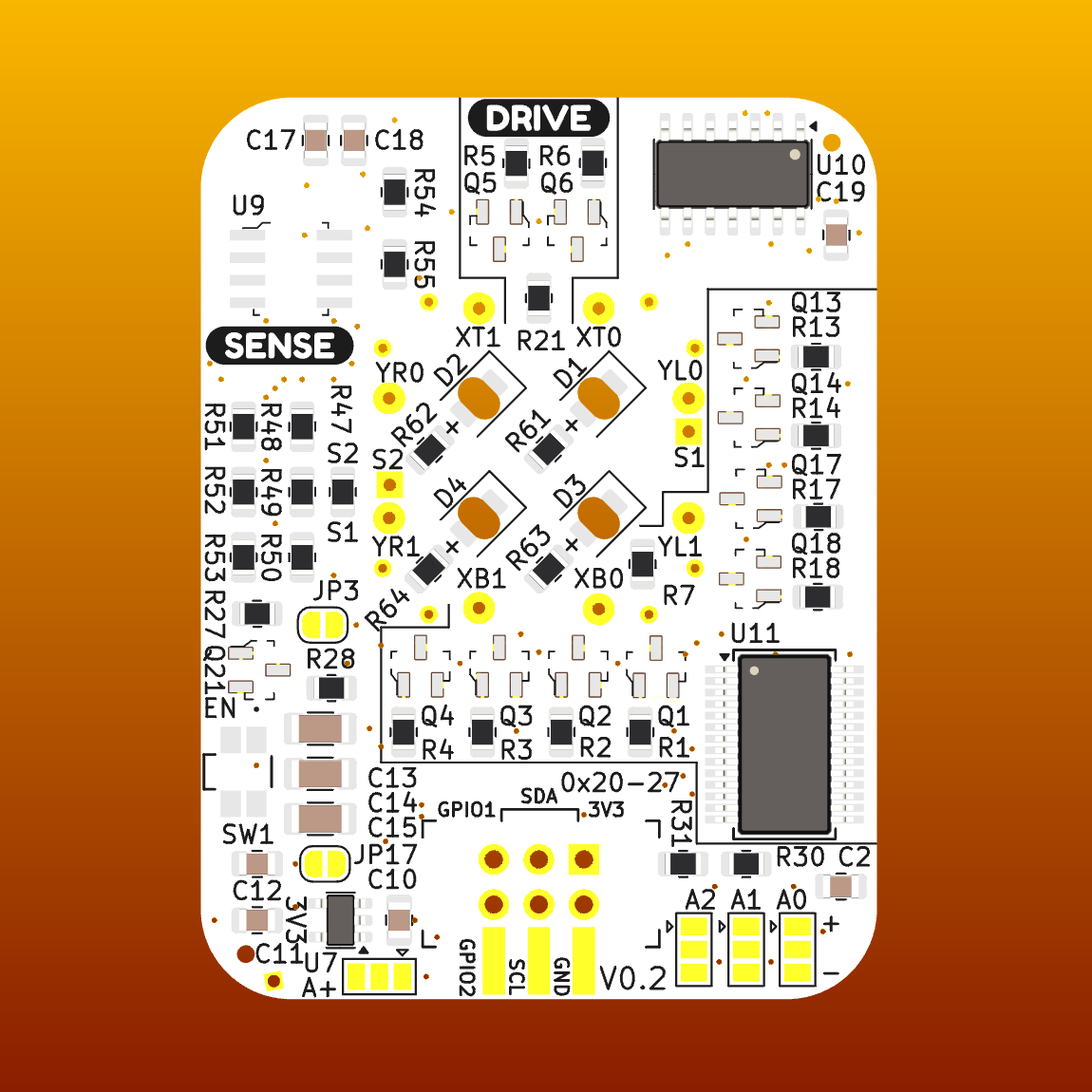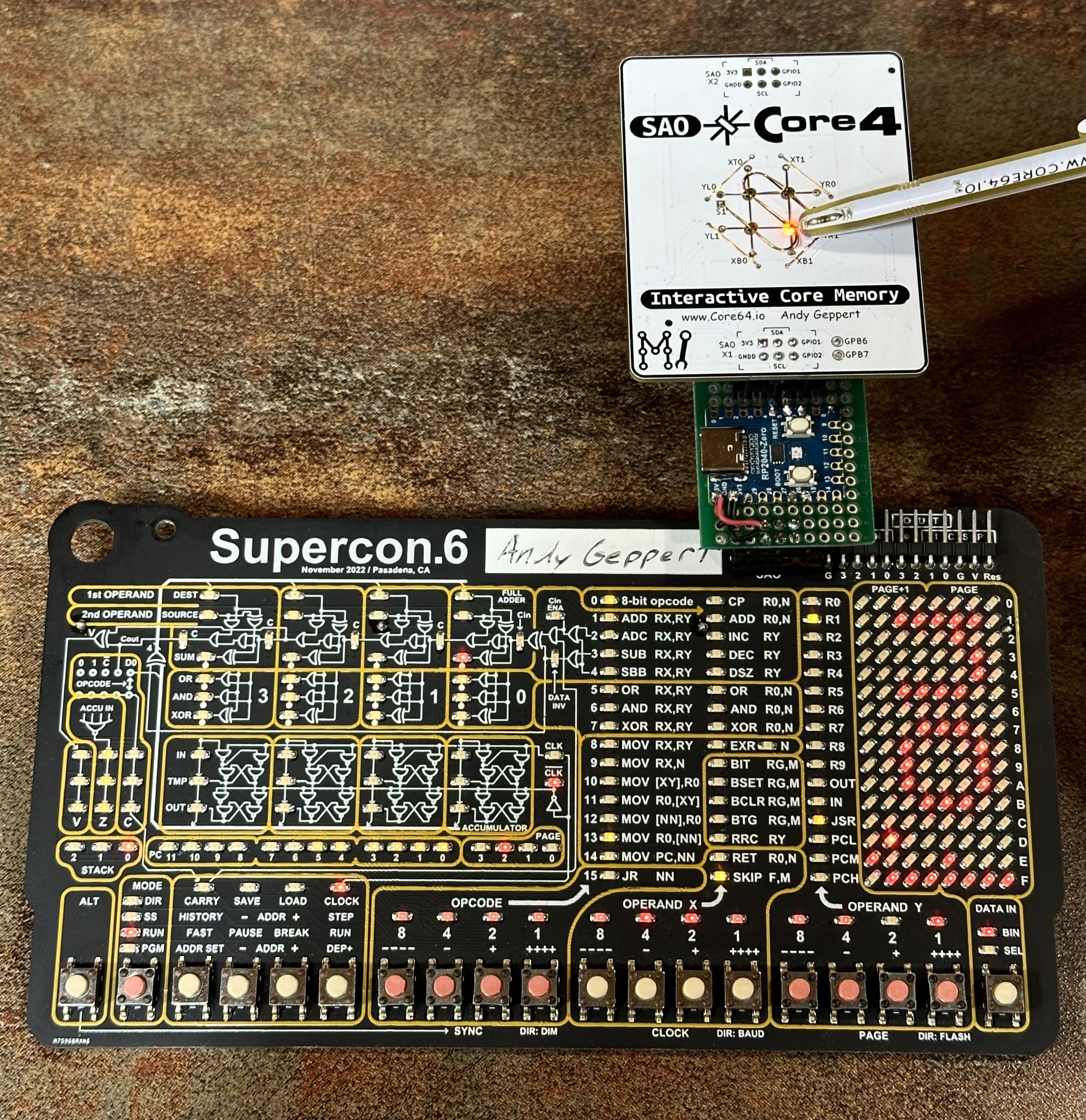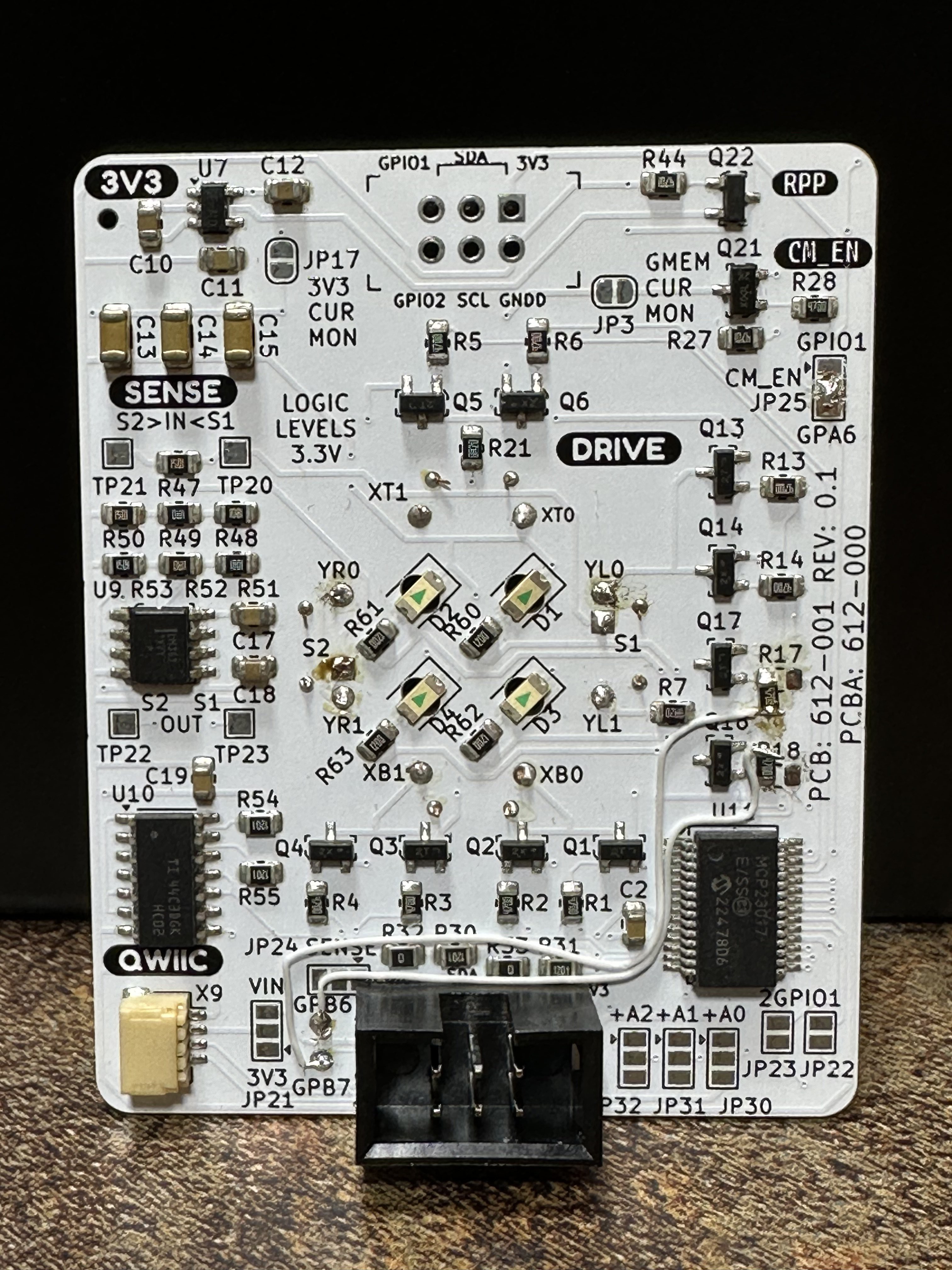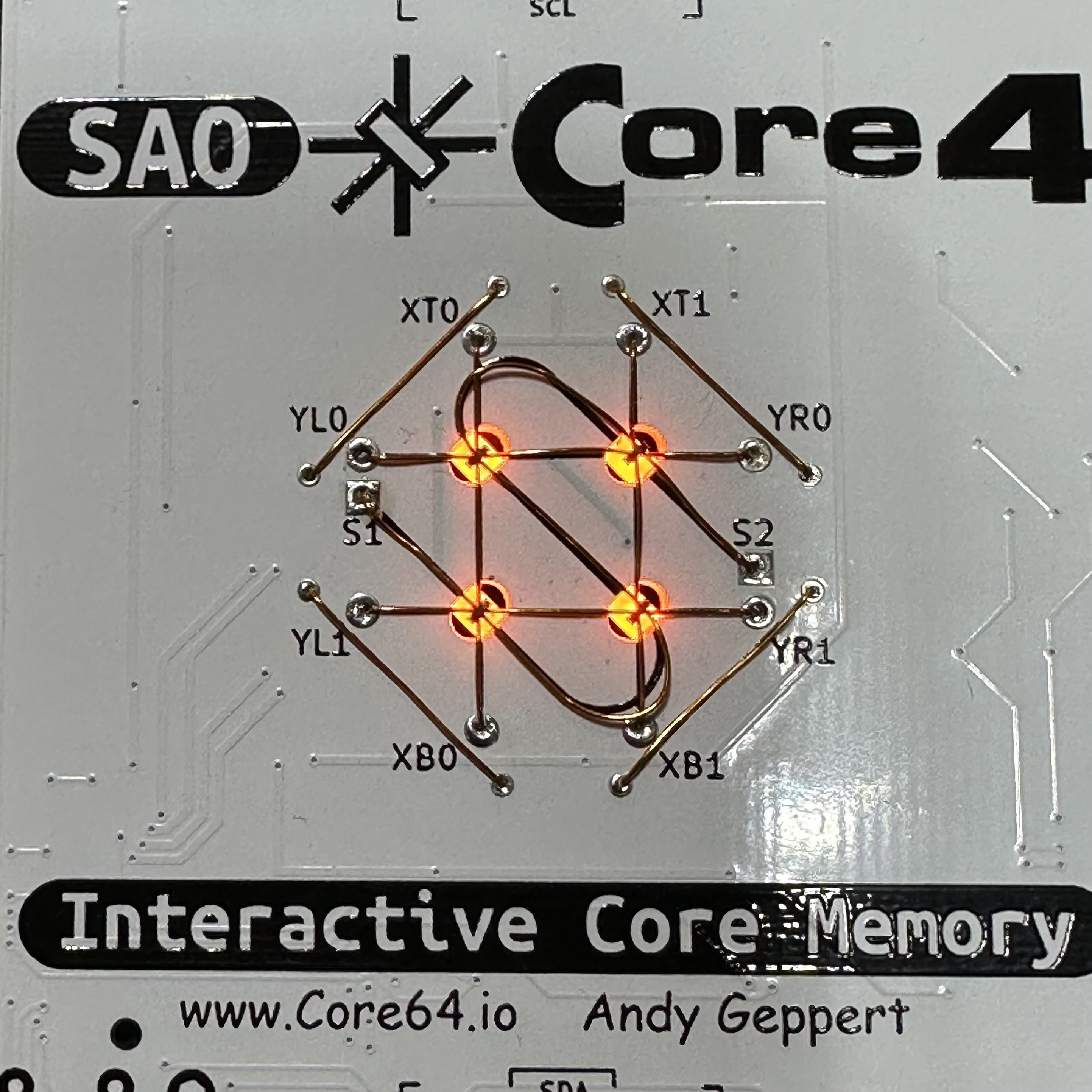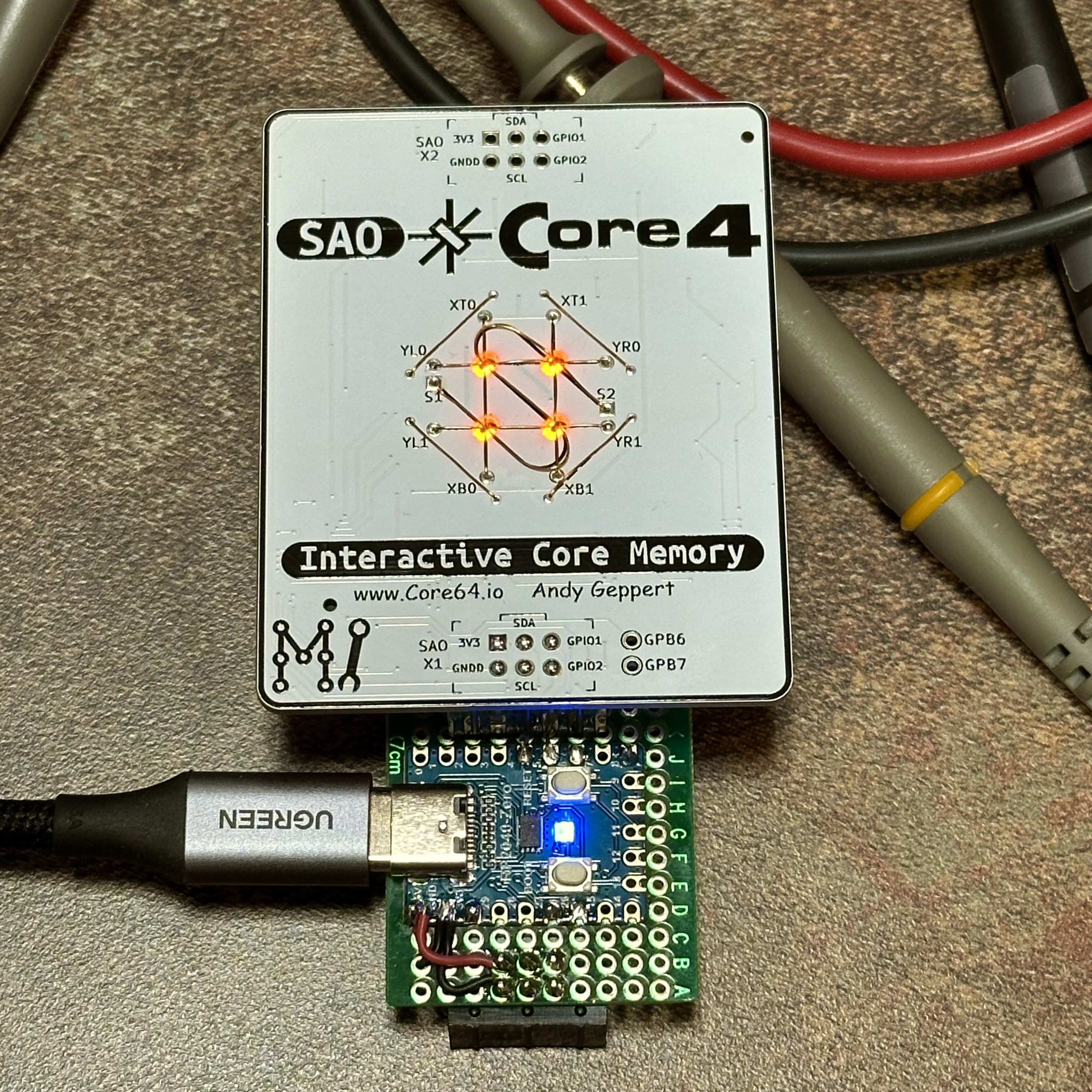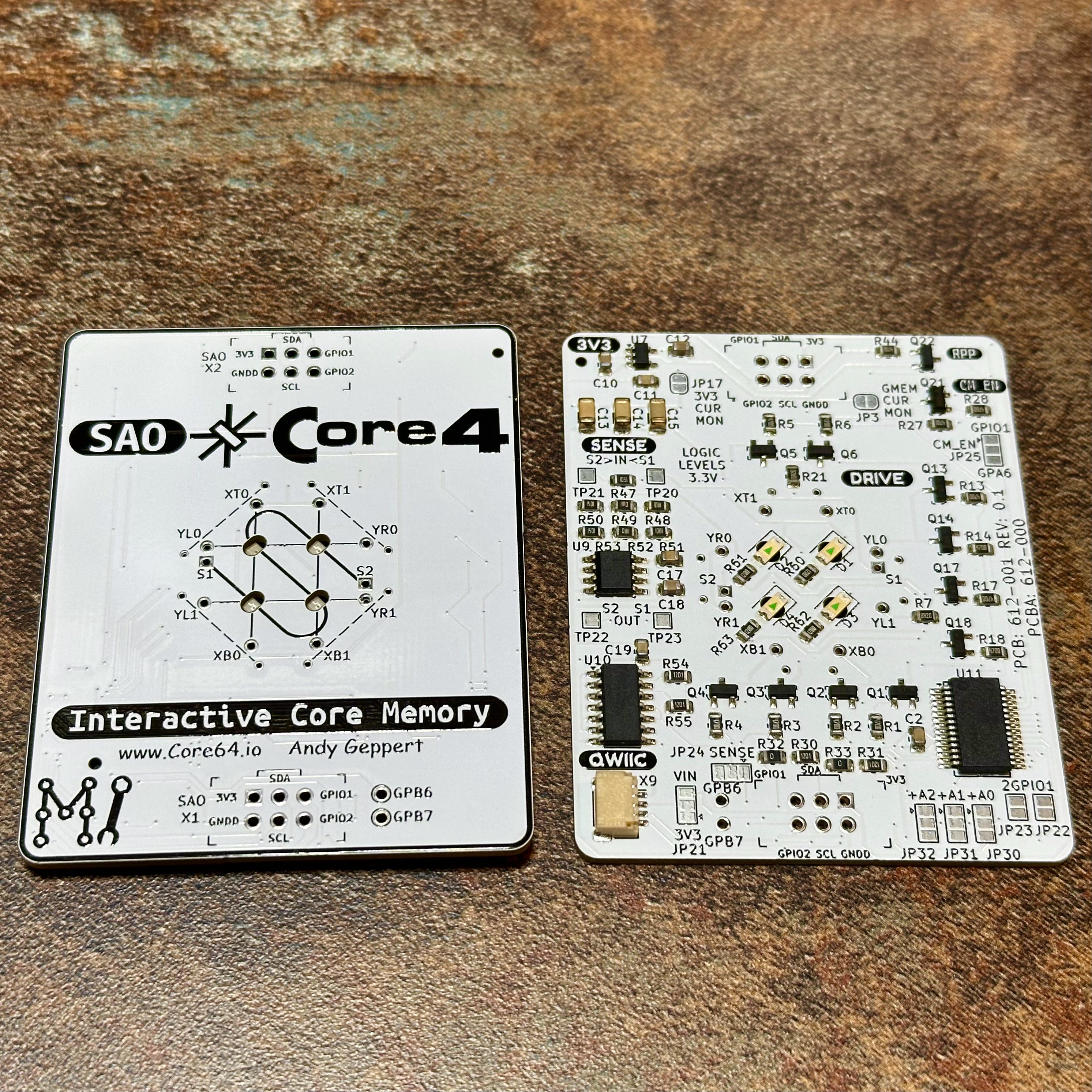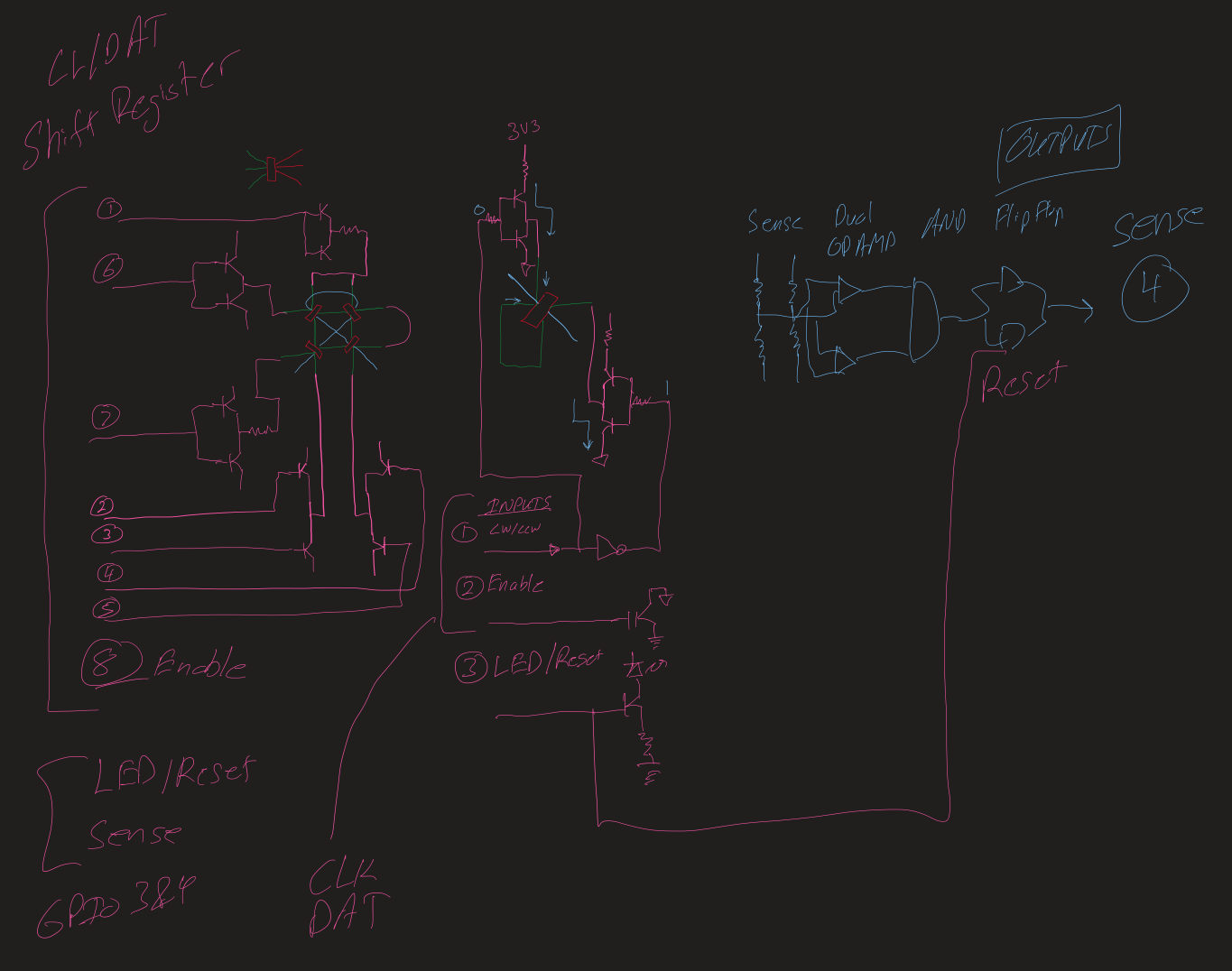-
Core4 V1.2 is Alive!
10/15/2024 at 03:51 • 0 commentsIt looks even better in the small form factor for the SAO Contest: 1.5x2.5 inches.

I look forward to sharing these with y'all. I did make at least one mistake which requires a rework... I connected the mode button circuit wrong to the symbol. Doh. Easy fix for the next batch, and I found a switch that I can use to rework the samples I have now. I also think I got the sense solder pads a little too close to the horizontal wire solder pads because there is a tiny amount of cross-talk affected the sense wire. Or, I am routing the sense wire curves too "parallel" to the vertical drive wires.
The screen protector is not shown above, but this has a provision for it with the small dotted lines in the corners.
-
The smaller version has arrived!
10/08/2024 at 13:59 • 0 commentsThis is the smaller version with several refinements to comply with the Supercon 8 Add-on Contest. It looks better in the smaller form factor, and I removed some experimental stuff from the previous version.
Here it is on the bench with testing underway:

One of the "improvements" I made has to do with pin allocation on the I2C GPIO Expander, as it related to the row wiring and also the LEDs. I think I made a mistake that is still functional, but changed polarities on the row drive wires. The newest version works, but I need to make some code tweaks to get it working as smoothly as the first version. More to come soon!
-
SAO Core4 V0.2 Design Released
09/24/2024 at 14:15 • 0 commentsThe updated version was just released to fabrication! V0.2 changes include:
- Size reduced (1.5 x 2.0 inches) to comply with the Supercon Add On Contest rules.
- Still requires a badge/host MCU to control the SAO (or use my tiny SAO Demo Controller).
- Added edge-connect option for SAO header mounting.
- Removed some prototype features that aren't needed anymore, simplified pin usage on the IO expander.
- Refined core memory weaving outline and make screen protector easier to install.
- Add I2C address on the front! Still adjustable with solder jumpers on the back.
- Add alternate power input (square pin in the open-end wrench, lower right) to avoid overloading SAO power rail.
- Define tooling pin locations for fabrication.


-
Tiny Games Challenge is closing soon!
09/10/2024 at 02:19 • 0 commentsI added Assembly Guide and Theory of Operation documents:
https://github.com/ageppert/SAO_CORE4/tree/main/Documentation
I also added a V0.1.1 schematic with redlines showing the rework:
https://github.com/ageppert/SAO_CORE4/tree/main/Electronic%20Design/SAO_Core4_V0.1.1%20Schematic
At VCF Midwest 2024 a few early adopters purchased kits. Thank you for your support! The assembly guide covers the changes needed to convert your boards from V0.1.0 to V0.1.1 with the wire included in the kit. The documentation updates noted above will guide that rework.
The same Github repo also includes sample code which can get you up and running with pretty much any generic Arduino-compatible MCU board. I used an RP2040-Zero for my testing and the demo game of memory.
I will resume work on hardware Version 0.2 after the contest closes. I plan to bring Hardware Version 0.2 to Supercon 2024.
-
A game of memory, in core memory
09/03/2024 at 04:16 • 0 commentsIt was meant to be!
This simple game is surprisingly fun! I think there is a lot of possibilities with Core4! I'm looking forward to sharing this and seeing what other people come up with.
-
Cores are working!
09/01/2024 at 03:50 • 0 commentsThis is a break-through day of progress. All of the core functionality is working! This is the one and only mode I have right now - FLUX DETECTOR:

I've been doing this core thing for awhile, and was pleasantly surprised to find the bring-up process went smoothly. At least, from the design perspective. Had some weird issues with the Arduino IDE, but it's working fine now. And I made really dumb code comment error that sent me way off the path with some compiler messages that did not compute.
The MCU running this is an RP2040 Zero. I'm using that to see how it works, and it is a candidate for another SAO MCU project. I'm enjoying the USB-C port. I wish all the Pico boards came with that! The other MCU I'm considering is an ESP32-C3, which would open the door for Wifi and BT. Another project for later...
In the photo above, the Voja4 badge is just supplying power to the RP2040 and the Core4. I was happy to see that end of the voltage range was still able to drive the badge and the SAO.
As I started to build out some documentation of the core activation process in the code, I quickly realized that a "clever" design change made understanding how the cores work more difficult. It did free up 2 GPIO pins on the IO Expander, but I decided to commit to a more straightforward electronic design, to make this easier for people to develop their own firmware with. So I've backed out that optimization, and have already started working on the next board design which strips out several features I included in the first prototypes. Most of those features were to give me flexibility to experiment and test. Now that the design is functioning, and I've chosen to simplify, I'm going to reduce the size of the board for the SAO Challenge. But, that's work for later on.
Here is what the design changes look like - relatively minor with the resistor rotations and 2 white wires:

More to come later this weekend. I think the next update will include a video of a game demo!
Meanwhile, if you have feedback on my plans for these features, let me know.
- Remove the 3V3 regulator
- Remove the 3V3 bulk storage caps
- Remove the reverse polarity protection FET
- Remove several optional solder jumpers which allow pin usage changes
- Remove the QWIIC port
- Remove the top (2nd) SAO pass-through port.
- Keep the IO Expander address setting jumpers, perhaps make them smaller.
- I'm only using GPIO2 of the SAO. GPIO1 remains open for other use. Yah know, a button would be nice to change modes... Hmmmm...
-
Blinking in Orange
08/30/2024 at 04:10 • 0 commentsThe IO Expander is working and blinking the built-in LEDs!

Oh, and I wove the core memory too!
The first demo sketch will be in the basic Arduino environment, with the I2C Wire Library, and directly reading/writing to the registers of the MCP23017 IO Expander. At the moment, I'm testing the prototype Core4 with another prototype, a simple inline SAO with an RP2040-Zero. This little board will draw power from a host SAO (or USB C port) and pass the power up to the SAO plugging into the top. The RP2040 is also connected to the TOP SAO port I2C and GPIO1&2 lines.

Next step, control all the IO to write some core memory!
-
Boards have arrived!
08/29/2024 at 04:55 • 0 comments -
Core4 Concept
08/18/2024 at 21:49 • 0 commentsLate in 2023, the concept for this project hatched from a conversation with KoppanyH after Supercon, where I shared the Core16 proejct. I threw together this sketch to start capturing the concept.

The essence of the idea is to provide a simple drive circuit and weaving experience to enable anyone to control this with their own hardware. I was already thinking about how to minimize the number of external pins, with SAOs in mind.
I also wanted it to be accessible with ANY hardware. Since I2C can be bit-banged, the MCP23017 seemed like a great choice. The sketch above is for illustration purposes - it's not how this will be wired up in reality.
The project concept sat on the back burner, waiting for a catalyst. That catalyst happened in July 2024:
SAO Core4 - A Nibble of Core Memory with I2C
Add a nibble of Interactive Core Memory to your project!
 Andy Geppert
Andy Geppert